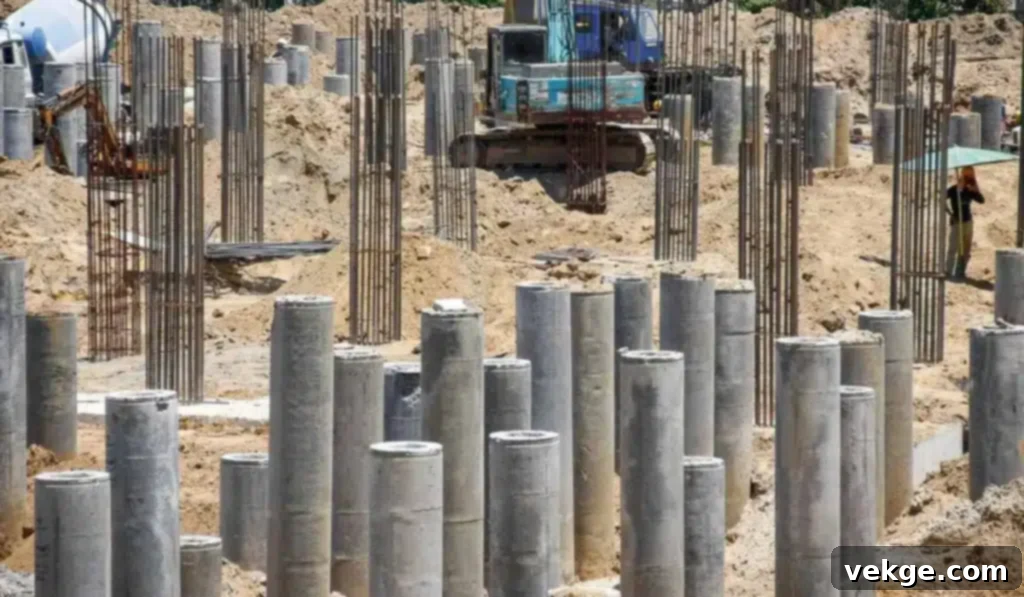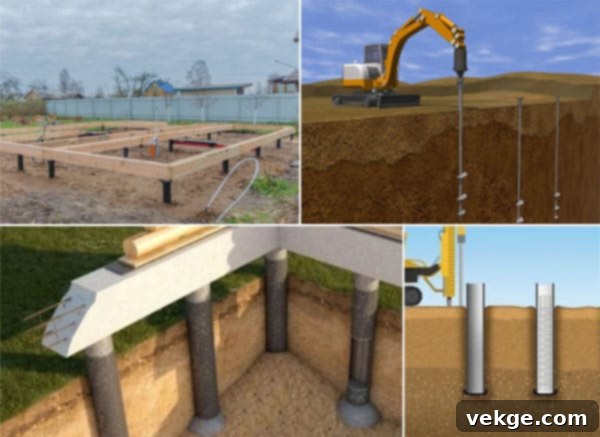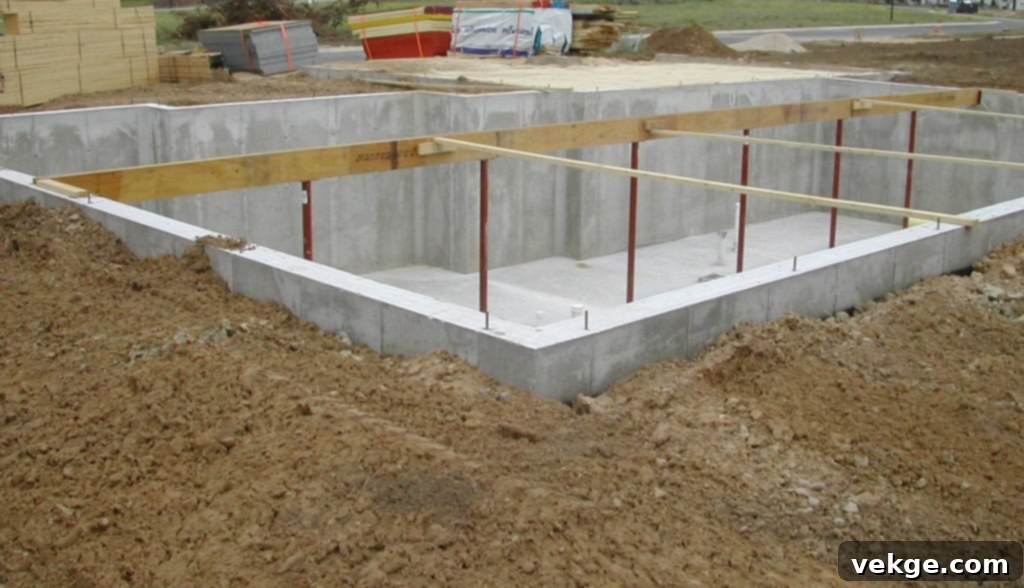Mastering Foundations: An In-Depth Guide to Piling Techniques and Expert Contractors
In the world of construction, the foundation is everything. It is the bedrock upon which the entire structure rests, dictating its strength, stability, and longevity. When it comes to creating truly robust buildings that stand the test of time, the critical role of piling and a professional bored pile contractor simply cannot be overstated. These foundational elements are not mere afterthoughts; they are pivotal in the initial phases of any construction project, laying the groundwork for enduring structural integrity.
Piling solutions significantly contribute to the resilience and stability of structures by transferring the building’s load to deeper, more stable soil layers. This process goes far beyond just placing a slab on the ground; it involves engineering sophisticated support systems designed to counteract the challenges posed by diverse soil conditions, heavy loads, and environmental factors. Understanding the fundamental concepts of piling, its numerous benefits, and the various techniques involved is crucial for ensuring the correct application in construction projects and guaranteeing the long-term success of any build.
This comprehensive guide will delve deep into the essential concept of piling, exploring its multifaceted importance, the diverse range of techniques available, and how professional expertise can make all the difference in achieving superior foundational strength.
What is Piling? Understanding the Core of Deep Foundations

Piling is a fundamental civil engineering technique employed to provide foundational support to structures, especially in areas characterized by challenging ground conditions such as loose or unstable soils, high water tables, or diverse geological strata. The primary purpose of piling is to transfer the structural load from the building above to a more competent and stable soil or rock layer situated at a greater depth, effectively bypassing weak superficial soils that cannot adequately bear the weight.
This process involves the installation of slender, column-like elements, known as piles, deep into the ground. These piles can be made from various materials, including concrete, steel, or timber, and are installed using specialized machinery and techniques. Once embedded, they act as deep foundations, distributing the weight of the structure over a larger, stronger area. When multiple piles are used, they are often interconnected with a pile cap to create a unified and incredibly strong base, ensuring long-lasting support for everything from multi-story buildings and bridges to communication towers and industrial facilities.
The effectiveness of piling, however, is highly dependent on the specific site conditions. Soil composition, groundwater levels, seismic activity, and the magnitude of the structural load all influence the type and design of piling required. Therefore, the meticulous selection of the correct piling method that perfectly aligns with the constructional needs and environmental context is paramount. This ensures optimal strength, stability, and durability, safeguarding the building against potential settlement, differential movement, and structural failure over its entire lifespan.
The Indispensable Benefits of Piling in Modern Construction
Piling offers a plethora of benefits that are essential for the structural integrity and long-term performance of any building or infrastructure project. These advantages highlight why deep foundations are often the preferred solution, particularly when superficial soil conditions are less than ideal:
- Superior Structural Stability: Piles transfer heavy loads to deeper, more competent soil or rock strata, preventing excessive settlement and ensuring the overall stability of the structure. This is crucial for large, multi-story buildings or structures built on weak, compressible soils.
- Enhanced Load-Bearing Capacity: Deep foundations provide significantly higher load-bearing capacity compared to shallow foundations, accommodating the immense weight of modern buildings and reducing the risk of foundation failure.
- Mitigation of Differential Settlement: By creating a uniform support system, piling helps prevent uneven settlement, which can lead to cracks, structural damage, and costly repairs in the future.
- Resistance to Uplift and Lateral Forces: Piles are designed not only to bear downward loads but also to resist uplift forces (e.g., from wind or hydrostatic pressure) and lateral forces (e.g., from earthquakes or expansive soils), making structures safer and more resilient.
- Adaptability to Challenging Soil Conditions: Piling solutions are versatile enough to be employed in a wide range of difficult ground conditions, including soft clays, silts, loose sands, expansive soils, and areas with high water tables, where conventional shallow foundations would be unsuitable.
- Durability and Longevity: Properly designed and installed piles ensure a durable foundation that can withstand environmental stresses and provide structural support for many decades, minimizing maintenance requirements and extending the building’s lifespan.
- Reduced Excavation: Some piling methods, like bored or screw piling, require less extensive excavation compared to traditional spread footings, which can be beneficial in urban environments with limited space or when trying to minimize site disruption.
Exploring Diverse Piling Techniques: Tailored Solutions for Every Project

In the dynamic landscape of the construction and building industry, the concept of piling has evolved significantly with modern innovations. While the fundamental principle remains the same – transferring loads to deeper strata – various specialized techniques have emerged, each offering unique advantages for specific construction scenarios. Understanding these diverse methods is crucial for making informed decisions that optimize both structural performance and project economics. Piling techniques are generally classified based on their installation methods, applications, and suitability for different soil types and project constraints.
Bored Piling: Precision and Power in Deep Foundations
Bored piling is one of the most effective and widely utilized deep foundation techniques, especially for creating strong support foundations in challenging conditions or in urban environments. The process involves drilling a cylindrical hole deep into the ground using a specialized auger or drilling rig. As the drilling progresses, soil and sometimes rock are systematically removed from the bore. Once the desired depth and diameter are achieved, a steel reinforcement cage is lowered into the hole. Finally, the hole is filled with concrete, often placed using a tremie pipe to ensure a continuous and void-free column. The term “bored” precisely refers to the act of excavating the soil by drilling, rather than driving, which minimizes ground vibration and noise.
This method is particularly advantageous in areas where space is limited or where adjacent structures are sensitive to vibrations, making it a preferred choice for city-center developments. Bored piles can be designed to accommodate very heavy loads and can extend to significant depths, making them suitable for high-rise buildings, large bridges, and structures requiring substantial foundational support. While the process can be more time-consuming and costly than some other piling methods due to excavation and concrete curing times, its high load capacity, adaptability to varying ground conditions, and minimal environmental disturbance often make it the ideal solution, especially when performed by an experienced bored pile contractor.
Screw Piling: Speed, Efficiency, and Minimal Disruption
As the name suggests, screw piling, also known as helical piling, involves installing screw-like steel shafts into the soil. These piles consist of a central steel shaft with one or more helical (spiral) plates welded to it, resembling a large screw. The piles are drilled into the ground using specialized hydraulic torque motors, much like a wood screw entering timber. The helical plates act as both an auger during installation and as bearing plates once installed, providing significant load-bearing capacity by compacting the surrounding soil.
Screw piling is renowned for its versatility, speed of installation, and cost-effectiveness. It minimizes soil disturbance, which means less spoil to remove from the site and reduced environmental impact. Furthermore, screw piles offer immediate load-bearing capacity upon installation, eliminating the waiting time associated with concrete curing. Their ability to be installed in various ground conditions, including expansive clays and areas with high water tables, without the need for dewatering, makes them a highly attractive option. This technique is widely used for residential foundations, communication towers, solar panel installations, temporary structures, and even for underpinning existing buildings, offering a reliable, quick, and environmentally conscious foundation solution.

Micro Piling: Solutions for Restricted Access and Challenging Soils
Micro piling, also known as mini piling or pin piling, is a highly effective deep foundation technique specifically designed for areas with challenging soil conditions, restricted access, or where traditional piling methods may be impractical. These are small-diameter piles, typically ranging from 50 mm to 300 mm, installed by drilling or jacking. The installation process usually involves drilling a small-diameter hole, inserting a high-strength steel casing or bar, and then filling the annular space with cement grout under pressure. This grouting process not only secures the pile but also improves the surrounding soil, enhancing its strength and stiffness.
Micro piles are celebrated for their versatility and minimal environmental footprint. They can be installed with small, specialized equipment, allowing them to be used inside existing buildings for underpinning, in areas with low headroom, or in environmentally sensitive zones where larger machinery would cause too much disruption. Their ability to carry significant tensile, compressive, and lateral loads, combined with their adaptability to complex ground conditions (including rock, broken ground, and unstable soils), makes them a cost-effective and highly reliable solution for underpinning existing structures, slope stabilization, seismic retrofitting, and bridge foundation repair.
Hollow Stem Piling: Continuous Flight Auger (CFA) Piles for Soft Ground
Another highly effective piling technique is Auger-Cast piling, commonly referred to as hollow stem piling or Continuous Flight Auger (CFA) piling. This method is particularly efficient in conditions where a reliable, non-displacement deep foundation solution is needed, especially in soft to medium cohesive soils and granular soils below the water table. The process involves a continuous flight auger with a hollow central stem. The auger is drilled into the ground to the required depth, and as it is slowly withdrawn, concrete or grout is pumped under pressure through the hollow stem, filling the bore from the bottom up. This simultaneous drilling and concrete injection ensures that the hole remains stable and prevents soil collapse, creating a continuous, watertight concrete pile.
The resulting auger-cast piles provide a strong foundation with excellent load-bearing characteristics. A significant advantage of hollow stem piling is its speed of installation, as it combines drilling and concreting into one continuous operation. It also generates less noise and vibration compared to driven piles, making it suitable for urban settings. CFA piling is widely used not only to create foundations for commercial and industrial buildings but also for bridge abutments, retaining walls, and other structures where deep support in challenging soil conditions is essential. Its efficiency and reduced environmental impact make it a popular choice for large-scale infrastructure projects.
The Indispensable Role of Professional Piling Contractors
In the dynamic and often complex world of construction, the decision to engage a professional piling contractor is not just a recommendation—it is a critical necessity. While understanding the various piling techniques is valuable, the execution of these specialized methods requires extensive expertise, state-of-the-art equipment, and a deep understanding of geotechnical engineering principles. A seasoned contractor brings invaluable experience to the table, ensuring that the chosen piling solution is not only technically sound but also optimally aligned with the project’s specific requirements, budget, and timeline.
Professional piling contractors possess the knowledge to conduct thorough site investigations, accurately assess soil conditions, and interpret complex geotechnical reports. This expertise allows them to recommend the most appropriate piling type – whether it’s bored piling, screw piling, micro piling, or hollow stem piling – and design the pile dimensions and layout for maximum efficiency and safety. They are also adept at navigating regulatory requirements, implementing stringent safety protocols, and managing the logistical complexities of deep foundation construction. Entrusting your foundation work to experts like a reputable bored pile contractor ensures that the project benefits from precision engineering, superior craftsmanship, and a commitment to long-term structural integrity. This partnership minimizes risks, prevents costly errors, and ultimately provides peace of mind that your building’s foundation is in the most capable hands.
Key Takeaway: Building Stronger Futures with Smart Foundations
In the intricate and ever-evolving landscape of the construction and building industry, piling serves as a critical cornerstone for building strong, stable, and enduring foundations. Its multifaceted role in ensuring structural stability, distributing heavy loads, and overcoming challenging ground conditions cannot be overstated. By thoroughly understanding the concept of piling, appreciating its diverse types—including bored piling, screw piling, micro piling, and hollow stem piling—and recognizing their unique applications, stakeholders can make truly informed decisions that profoundly impact a building’s strength and longevity.
However, theoretical knowledge alone is insufficient. The successful implementation of any piling technique hinges on the expertise of experienced professionals. Always prioritize following the instructions and recommendations of qualified construction engineers and specialized piling contractors. Their invaluable experience, profound knowledge of geotechnical engineering, and deep understanding of how different piling methods interact with specific soil conditions are indispensable. This professional guidance is crucial for making the ideal decision, selecting the most appropriate and effective piling solution, and ultimately elevating your building’s strength, stability, and safety for generations to come. A robust foundation is not just an investment in a structure; it’s an investment in a stronger, safer future.
